Thomas Bay & Petersburg
The quiet morning found us at a very small little cove called Scenery Cove. Stories tell of a haunted place, where strange things have been seen, and even a small book, “The Strangest Story ever Told” of Cope, has been written. We hoped to see a bear at the flats of the cove, but no such luck.
Awhile later we were out of the cove, in Thomas Bay, and en route to our morning destination: Cascade Creek. In the distance we caught good views of Baird Glacier, which is now completely on land, having left behind its terminal moraine, consisting of millions of tons of gravel and sand.
Our walk at Cascade Creek was lovely. The walk is protected by a boardwalk, and the forest is well conserved, even if part of the area was logged around 40 years ago. A magnificent, roaring cascade dominates the views, creating its own wind, which drags a good amount of water into the path. Newts were found in the area, one of the few amphibians in the state. In the roaring waters we saw a couple of dippers, or water ouzels, an interesting bird species that walks along the bottom of the water courses, looking for prey.
By midday we were bound for Petersburg on Mitkof Island, where we had good plans for flights and hikes. Once there, we set out on hikes on the island of Kupreanof, just across the Wrangel Narrows, to an extensive bog, where we learned about the adaptation of so many plants to acid waters. Though the muskeg (or also called bog) was very dry, we did see a good number of bog plants such as buckbean, dwarf blueberry, bog cranberry, bog orchid and cotton grass. Below the bog on the path we saw a very interesting small plant, the twinflower, which was named by Grenobius of Sweden Linnaea in honor of Carl Linneaus, in the mid 1700’s. This small plant has a circumpolar distribution, therefore is a native plant to the area.
After an interesting recap, a scrumptious Dungeness crab dinner was served, as we sailed on to the West, into Frederick Sound.




